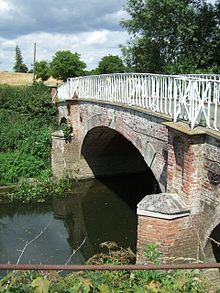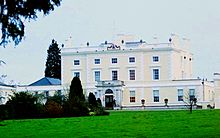- Norbury Park
-
Norbury Park is a swathe of land arranged around a small manor house near Leatherhead and Dorking, Surrey, which appears in the Domesday Book of 1086. The manor was also known as Northbury for some time.[1]
A small Bronze Age hoard consisting of two palstave axes and a scabbard chape dating from around 1150-1000 BC was discovered in 2003 in woodland on the western side of the park.[2] The park also contain an important grove of yew trees used by Druids for rituals and ceremony. They are some of the oldest trees of Great Britian.
The Park was owned for two centuries by the Stydolf family and the diarist John Evelyn records a visit in August 1655 to both Box Hill, Surrey and Norbury Park, which was then owned by Sir Francis Stydolf. Sir Francis' son Richard, who was created a baronet by Charles II subsequently inherited the estate and on his death it passed to his daughter, who married Thomas Tryon of Leatherhead. The estate remained in the Tryon family until 1766 when Charles Tryon (father of William Tryon the Governor of North Carolina) sold the estate to William Locke, a London art critic. Locke was responsible for the abandonment of the original site of the manor house on the floodplain of the River Mole and the construction of the current house, designed in 1774 by the architect Thomas Sandby. Locke commissioned the Irish landscape artist George Barrett Sr. to decorate one of the main reception rooms.[1]
 Grade II* listed Weir Bridge over the River Mole built in 1840.[3]
Grade II* listed Weir Bridge over the River Mole built in 1840.[3]
Locke died in 1810 and his family left Norbury Park in 1819.[1] Ebenezer Fuller Maitland, the former MP for Wallingford purchased the house in around 1822, exchanging it for Park Place in Berkshire, with Henry Piper Sperling. Sperling remained at Norbury Park for 24 years and was responsible for developing the gardens around the House, including the building of Weir Bridge over the River Mole, which still stands today and is Grade II* listed.[3]
The estate was purchased in 1850 by Thomas Grissell. It was home to Leopold Salomons JP by 1911. He gave Box Hill to the nation in 1914. Salomons died on 23 September 1915.[4] The Norbury Park estate appears to have been partly broken up by the executors of Salomons' will. The House, stud farm and 634 acres of parkland were purchased by Sir William Corry in September 1916.[5] In August 1922 he sold the property to Sir Edward Mountain, the chairman and managing director of the Eagle Star Insurance Company.[6]
Surrey County Council purchased 1340 acres of Norbury Park in July 1930 for £85 000 to protect the land from development.[7] The parkland remains the property of the council today and is managed on their behalf by the Surrey Wildlife Trust.
Marie Stopes, the British scientist and writer, lived at Norbury Park House from 1938 to 1958. She had been an active proponent of sexual education and birth control in the early twentieth century; her book Married Love, published in 1918, was the first sexual manual written in language simple enough to be accessible to a wide public and in 1921 she opened the first birth control clinic in London. On her death in 1958 she bequeathed the Park to the Royal Society of Literature, of which she was a member. The house was subsequently sold to Philip Spencer, an industrialist.[8]
References
- ^ a b c "Norbury Park: Summer all the winter". The Times (London): p17. 13 April 1934.
- ^ Williams D (2008). "A late Bronze Age hoard from Norbury Park, Mickleham". Surrey Archaeological Collections (Surrey Archaeological Society) 94: 293–301.
- ^ a b Shepperd, Ronald (1991). Micklam the story of a parish. Mickleham Publications. ISBN 0951830503.
- ^ "Probabte, Divorce and Admiralty Division". The Times (London): p4. 6 July 1916.
- ^ "The Estate Market". The Times (London): p11. 16 September 1916.
- ^ "The Estate Market". The Times (London): p10. 23 August 1922.
- ^ "Norbury Park". The Times (London): p14. 30 July 1930.
- ^ "Norbury Park Plaque to Marie Stopes". The Times (London): p7. 2 May 1961.
Surrey Hills Area of Outstanding Natural Beauty North Downs Botley Hill · Box Hill · Combe Bottom · Gatton Park · Hackhurst and White Downs · Headley Heath · Hog's Back · Mole Gap to Reigate Escarpment · Newlands Corner · Norbury Park · Ranmore Common · Seale Chalk Pit · Woldingham and Oxted DownsGreensand Ridge Albury Heath · Blackheath · Colyers Hanger · Devil's Jumps · Devil's Punch Bowl · Frensham Common · Gibbet Hill · Gong Hill · Hankley Common · Hankley Farm · Leith Hill · Moor Park · Oxmoor Copse · Puttenham & Crooksbury Commons · St. Martha's Hill · Stockstone Quarry · Thursley Common · Winterfold Forest · Witley CommonLow Weald Rivers Lakes and ponds Frensham Ponds · Silent PoolLong Distance Paths Downs Link · Greensand Way · Mole Gap Trail · North Downs Way · Thames Down Link · Vanguard Way · Wey South PathNational Cycle Routes Categories:
Wikimedia Foundation. 2010.

